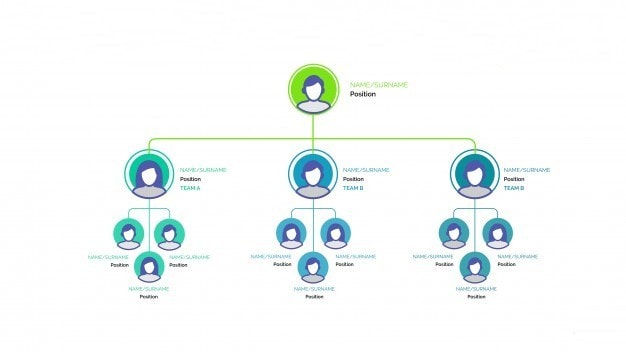Definition:
The organizational chart is defined as a diagram that visually displays the ranks and relationships of job positions in the company. It is used to show the organizational structure of a government, business or other organizations.
Table of Contents
What is Organizational chart?
The Organizational chart represents the flow of information, responsibility, and authority within an organization’s formal structure. It also shows the various management functions and its subdivisions graphically so that looking at it; a person can understand how the company is designed, its levels, and where every employee fits into that company.
The Organizational chart shows the following
- The relative position of every department in an organization
- The interrelationship of every department in a company
- Relationships between various managers in a company
- The names of managers and the employees they supervise in a company
- To identify omission of specific functions in an organization
- Pinpoints illogical groupings of functions in a company
An Organizational chart is also known as
- Organogram
- Organigram
Types of Organizational Chart
The three types of Organizational chart are as follows-
1. Hierarchical
This chart flows from top to bottom with major players and functions at the top and subordinates in successive lower positions. The hierarchical type of organization chart is built like a pyramid, and in it, the services run vertically as members communicate with the person they report to and anyone who reports to them directly.
In the hierarchical type of Organizational chart, the authority is clear and defined. The beneficial points are stability and clarity whereas rigidity is its limitation.
2. Flat
The flat Organizational chart is also known as a horizontal chart, and it positions people on the same level. It typically includes two levels, the top administrators and the lower one that contains workers.
It shows equality of power and the ability of autonomous decision making. The flat Organizational chart is suitable for smaller entities but not for large corporations. The benefits are autonomy and teamwork but conflicts amongst the employees are one of its limitations.
3. Matrix
It depicts a complicated Organizational structure where individuals are grouped as per their standard skill sets, the department they work and the head to which they report. An Organizational matrix chart interconnects teams and employees with more than one supervisor or manager.
The advantage of an Organizational matrix chart is that it is more cooperative and fruitful and its disadvantage is that there is a conflict of interest and this gives rise to divided loyalties
Uses of Organization charts
The Organizational chart is an essential management tool that is used for several purposes like
- Resource planning
- Workforce planning
- Showing work responsibilities
- Reporting relationships
- Manage change or growth
- Improving communication lines
- Budgeting
- Benchmarking to competitors
- Creating employee directory
- Restructuring
- Helping the employees in understanding the importance of their role
- Providing information about business structures
- Offering information about data hierarchies
Principles of Organizational charts
Keep in mind the following principles before framing an Organizational chart
- Make the Organizational chart flexible and simple
- The line of authority should be followed by the top management while dealing with subordinates. Do not try to bypass authority as it will make the chart meaningless
- Define the lines of position to avoid overlapping of job positions
- Avoid unnecessary concentration of duty at any given point
- It is essential to maintain the balance of the Organizational chart and not be influenced by individuals or personalities
Advantages
The advantages of the Organizational chart are as follows-
- It assists in specifying the responsibility and authority of every position in an organization
- It depicts the relationship between the staff members of an organization
- It helps to divide the functions of an organization and its departments
- It assists in designing and planning the Organizational structure to meet the objectives and goals of a business
- It defines the relationships between different people so that the workflow remains smooth
- It can identify if a workers workload is too heavy or not
- It assists in finding out about the competency of an employee in his position
- There is no chance of overlapping and duplication of duties
- It is an information center for the new hires because the visual display can help to understand various levels of responsibility and authority
- It outlines the various tasks of an employee and which supervisor is responsible for overseeing that employee’s task
- It helps in pointing out the deficiencies and faults in the organization so that prompt remedial action can be taken
- It is an essential tool as it helps in the decision-making process
- It enhances employee performances
- In some cases it helps to analyze the budget and generate reports
- It can design work teams
- It acts as a guiding force while making plans for expansion
Limitations
The limitations of Organizational charts are as follows-
- In organizations with significant turnover, the Organizational chart becomes out of date very quickly.
- The Organizational chart shows only formal relationships and does not depict social or informal relationships
- The Organizational chart shows a line of authority but not how it is exercised
- They do not include customers who are very important for an organization
- An outdated chart is worthless
- Keeping the chart updated is very hard as it needs constant changes at the drop of a hat that is not possible. Employees are changing departments, leaving the company, being assigned to new roles and making necessary changes is a time-consuming process
How to Draw Organizational charts?
Take the following steps to plan an Organizational chart
- Define the purpose – Think about the things that are useful for your purpose and plan accordingly. Include contact information, email links and photos to make it more purposeful
- Gather the data – gather all the information that you plan on using like contact information, pictures, etc. Clarify the lines of authority and write it down on the chart
- Break your chart – Break your Organizational chart into smaller and manageable pieces so that all the information remains consistent and leads to the highest Organizational level. Section off areas with various categories like unit, team, department, location, and project
- Include details – Include essential details about departments and the people. Adding location, contact information and other data can eliminate confusion and bring clarity
- Use shapes and colors – An critical way to give meaning to an Organizational chart is by defining particular groups by the use of shapes and colors
- Plan for updates – change is the only constant hence make room for change in the Organizational chart. Keep it updated so that it remains useful for a more extended time
Liked this post? Check out the complete series on Organizational Management



